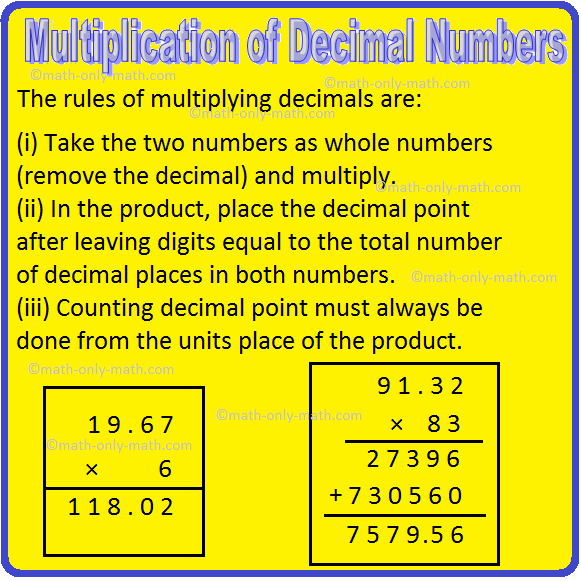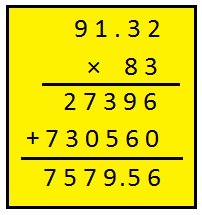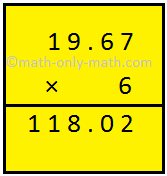Subscribe to our ▶️ YouTube channel 🔴 for the latest videos, updates, and tips.
Multiplication of Decimal Numbers
In multiplication of decimal numbers we will learn how to find the product of a decimal and a whole number.
The rules of multiplying decimals are:
(i) Take the two numbers as whole numbers (remove the decimal) and multiply.
(ii) In the product, place the decimal point after leaving digits equal to the total number of decimal places in both numbers.
(iii) Counting decimal point must always be done from the units place of the product.
A. Multiplication of a Decimal by a Whole Number
Let us follow some of the examples on multiplication of a decimal fraction by a whole number.
To multiply a decimal number by a whole number, we first multiply the two numbers ignoring the decimal points and then place the decimal point in the product to have the same number of decimal places as in the given decimal number.
1. Find 43.5 × 4.
First we will perform the multiplication ignoring decimal point.
Now place the decimal point in the product to get as many decimal places in the product as there are in the multiplicant. And, here the multiplicant contains one decimal place, so the product must contain one decimal place.
Thus, 43.5 × 4 = 174.0 = 174
2. Find 91.32 × 83.
First we will perform the multiplication ignoring decimal point.
Here the multiplicant contains two decimal places, so the product must contain two decimal places.
Thus, 91.32 × 83 = 7579.56
3. Find the product of 49.6 × 14
First perform multiplication ignoring decimal point as we do in whole numbers.
Here the multiplicant contains one decimal place, so the product must contain one decimal place.
Thus, 49.6 × 14 = 694.4
4. Multiply 19.67 by 6.
Solution:
19.67 × 6
In 19.67, there are 2 decimal places after the decimal point.
Place the decimal point to have two decimal places after the point.
B. Multiplying Two Decimals
In such a case also, we multiply the decimals as usual without any consideration of the decimal point. The product will have the same number of decimal places as the multiplicand and multiplier have together.
Let us consider some examples.
1. Multiply 24.16 by 2.3.
Solution:
Step I: Arrange the decimals in columns.
Step II: Multiply the numbers ignoring the decimal point.
2416 × 3 = 7248
2416 × 20 = + 48320
55568
Step III: Count the number of decimal places in the multiplicand and multiplier and add them. Here, it is 2 + 1 = 3
Step IV: Count 3 digits from the extreme right of the product and insert the decimal point 55568 → 55.568
Multiply 24.16 by 2.3.
24.16 → Decimal point after two digits from the right
× 2.3 → Decimal point after one digit from the right
7248
+ 48320
55.568 → Decimal point after three (2 + 1) digits from the right
Answer: 55.568
2. Multiply 125.32 by 3.23.
Solution:
Step I: Arrange the decimals in columns.
Step II: Multiply the numbers ignoring the decimal point.
12532 × 3 = 37596
12532 × 20 = 250640
12532 × 300 = + 3759600
4047836
Step III: Count the number of decimal places in the multiplicand and multiplier and add them. Here, it is 2 + 2 = 4
Step IV: Count 4 digits from the extreme right of the product and insert the decimal point 4047836 → 404.7836
Multiply 125.32 by 3.23.
125.32 → Decimal point after two digits from the right
× 3.23 → Decimal point after two digits from the right
37596
250640
+ 3759600
404.7836 → Decimal point after four (2 + 2) digits from the right
Answer: 404.7836
How to multiply of a decimal by a whole number?
How to multiply of a decimal by a whole number?
Answer: Multiplication of a decimal by a whole number To multiply a decimal by a whole number, we multiply exactly in the same way as we multiply two whole numbers without any consideration of the decimal point. Then we place the decimal point in the product at the same place where it is placed in the multiplicand
Let us understand it by considering an example.
Multiply 83.16 by 12.
Solution:
Step I: Arrange the numbers in columns.
Step II: Multiply the numbers ignoring the decimal point.
8316 × 2 = 16632
8316 × 10 = 83160
99792
Step III: Insert the decimal point in the product just after 2 digits from the right as it is placed in the multiplicand
99792 → 997.92
83.16 → Decimal point after two digits from the right
× 12
16632
+ 83160
997.92 → Decimal point after two digits from the right
Answer: 997.92
● Decimal.
- Tenth Place in Decimals
- Hundredths Place in Decimals
- Thousandths Place in Decimals
- Whole Numbers and Decimals
- Decimal Place Value Chart.
- Expanded form of Decimal Fractions
- Like Decimal Fractions.
- Unlike Decimal Fraction.
- Equivalent Decimal Fractions.
- Changing Unlike to Like Decimal Fractions.
- Ordering Decimals
- Comparison of Decimal Fractions.
- Conversion of a Decimal Fraction into a Fractional Number.
- Conversion of Fractions to Decimals Numbers.
- Addition of Decimal Fractions.
- Problems on Addition of Decimal Fractions
- Subtraction of Decimal Fractions.
- Problems on Subtraction of Decimal Fractions
- Multiplication of a Decimal Numbers.
- Multiplication of a Decimal by 10, 100, 1000
- Multiplication of a Decimal by a Decimal.
- Properties of Multiplication of Decimal Numbers.
- Problems on Multiplication of Decimal Fractions
- Division of a Decimal by a Whole Number.
- Division of Decimal Fractions
- Division of Decimal Fractions by Multiples.
- Division of a Decimal by a Decimal.
- Division of a whole number by a Decimal.
- Properties of Division of Decimal Numbers
- Problems on Division of Decimal Fractions
- Conversion of fraction to Decimal Fraction.
- Simplification in Decimals.
- Word Problems on Decimal.
5th Grade Numbers Page
5th Grade Math Problems
From Multiplication of Decimal Numbers to HOME PAGE
Didn't find what you were looking for? Or want to know more information about Math Only Math. Use this Google Search to find what you need.







New! Comments
Have your say about what you just read! Leave me a comment in the box below. Ask a Question or Answer a Question.